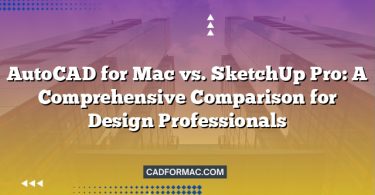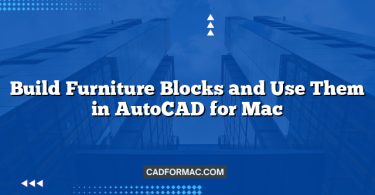When choosing CAD software for your Mac, two prominent options often rise to the top: AutoCAD for Mac and Vectorworks Fundamentals. Both are powerful design tools, but they cater to different workflows, industries, and user preferences. Whether you’re an architect, engineer, interior designer, or landscape professional, understanding the strengths and limitations of each platform is essential to making an informed decision.
This article provides a detailed, side-by-side comparison of AutoCAD Mac and Vectorworks Fundamentals, covering interface, functionality, industry focus, performance, pricing, and more—so you can select the right tool for your creative and technical needs.
Overview
AutoCAD for Mac
Developed by Autodesk, AutoCAD is one of the most widely recognized CAD programs in the world. The Mac version offers a native macOS experience while maintaining core compatibility with the Windows counterpart. AutoCAD excels in 2D drafting and documentation, with robust 3D modeling capabilities that appeal to engineers, architects, and construction professionals.
Vectorworks Fundamentals
Vectorworks Fundamentals is the base version of the Vectorworks suite by Nemetschek Vectorworks, Inc. Built from the ground up for macOS (and Windows), it combines 2D drafting, 3D modeling, and BIM-like features in a unified environment. While Fundamentals lacks the specialized tools of Vectorworks Architect or Landmark, it’s a versatile platform suitable for general design, drafting, and conceptual modeling.
Interface & User Experience
AutoCAD Mac
- Familiarity: If you’ve used AutoCAD on Windows, the Mac version will feel largely familiar, though adapted to macOS conventions.
- Ribbon Interface: Uses a ribbon-style toolbar similar to Microsoft Office, which some users find intuitive but others consider cluttered.
- Command Line: Retains the classic command-line input, beloved by power users for speed and precision.
- Customization: Highly customizable workspace, tool palettes, and shortcuts—but the learning curve can be steep for beginners.
Vectorworks Fundamentals
- Mac-Native Design: Feels more “at home” on macOS, with a cleaner, more modern interface that follows Apple’s Human Interface Guidelines.
- Tool Palettes: Organized into dockable palettes (e.g., Attributes, Object Info, Resource Manager) that streamline workflow without overwhelming the screen.
- Contextual Tools: Tools adapt based on selection, reducing the need to hunt through menus.
- Learning Curve: Generally gentler for new users, especially those coming from graphic design or illustration backgrounds.
Verdict: Vectorworks offers a more polished macOS-native experience, while AutoCAD provides powerful but denser interface options favored by long-time CAD users.
Core Functionality
2D Drafting
- AutoCAD Mac: Industry standard for precision 2D drafting. Offers unparalleled control over linework, layers, dimensions, and annotations. Supports DWG natively—the de facto file format in many industries.
- Vectorworks Fundamentals: Strong 2D capabilities with intelligent objects (e.g., walls, doors, windows—even in Fundamentals). Vector-based drawing is smooth and integrates well with 3D. However, it uses its own .vwx format, which may require exporting to DWG for collaboration.
Winner for 2D Precision: AutoCAD
Winner for Integrated 2D/3D Workflow: Vectorworks
3D Modeling
- AutoCAD Mac: Offers solid, surface, and mesh modeling. While capable, its 3D tools are often considered less intuitive than dedicated modeling software. Best suited for mechanical or architectural massing rather than organic forms.
- Vectorworks Fundamentals: Features a robust 3D modeling engine (based on Parasolid) with extrusions, sweeps, lofts, and NURBS. The 3D environment is tightly integrated with 2D plans—change a plan, and 3D updates automatically.
Winner for 3D Flexibility: Vectorworks
BIM & Parametric Objects
- AutoCAD Mac: Not a true BIM tool. While it supports dynamic blocks and some parametric features, it lacks intelligent building components. Users often pair it with Revit for BIM workflows.
- Vectorworks Fundamentals: Includes basic BIM-like functionality. Even in the Fundamentals version, objects like walls and slabs carry data and behave intelligently (e.g., walls clean up at intersections). Full BIM capabilities require upgrading to Vectorworks Architect.
Winner for BIM-Ready Features: Vectorworks
File Compatibility & Collaboration
- AutoCAD Mac: Native support for DWG/DXF—the gold standard in engineering and architecture. Excellent interoperability with other Autodesk products and most third-party tools.
- Vectorworks Fundamentals: Imports and exports DWG/DXF reliably, but complex files may lose some formatting or layer structure. Also supports PDF, IFC (for BIM exchange), and image formats. Collaboration is smoother within Vectorworks ecosystems.
Verdict: AutoCAD wins for universal compatibility, especially in firms that rely heavily on DWG workflows.
Performance & Stability
- AutoCAD Mac: Performance has improved over the years but can still lag behind the Windows version in speed and feature parity. Large drawings may slow down on older Macs.
- Vectorworks Fundamentals: Optimized for macOS, with generally smooth performance even on mid-range Macs. Handles complex 3D models efficiently thanks to its modern rendering engine.
Both applications are stable under macOS Sonoma and Ventura, though Vectorworks tends to feel more responsive in day-to-day use.
Industry Focus
| Industry | AutoCAD Mac | Vectorworks Fundamentals |
|---|---|---|
| Architecture | Strong for drafting; weak for BIM | Good for conceptual design; upgrade needed for full BIM |
| Engineering | Excellent (mechanical, civil) | Limited; not ideal for technical engineering |
| Interior Design | Functional but rigid | Highly visual; great for space planning & rendering |
| Landscape Design | Possible with add-ons | Requires Vectorworks Landmark (Fundamentals lacks plant database) |
| Entertainment (Theater, Lighting) | Not suited | Requires Vectorworks Spotlight |
Takeaway: AutoCAD dominates in engineering and technical fields; Vectorworks shines in design-centric disciplines.
Pricing & Licensing
AutoCAD for Mac
- Subscription: ~$240/month or $1,925/year (as of 2024)
- Perpetual License: No longer available—Autodesk moved to subscription-only.
- Student/Educational: Free for qualifying students and educators.
Vectorworks Fundamentals
- Perpetual License: ~$2,175 one-time (includes first-year service)
- Annual Subscription: ~$1,530/year
- Student/Educational: Free for students through academic institutions.
Note: Vectorworks offers more flexible ownership (perpetual option), while AutoCAD locks users into subscription.
Rendering & Visualization
- AutoCAD Mac: Basic rendering via Autodesk Raytracer. Adequate for quick previews but not for presentation-quality visuals. Most users export to 3ds Max or Lumion.
- Vectorworks Fundamentals: Includes Renderworks (based on Cinema 4D engine) even in the Fundamentals version. Offers realistic materials, lighting, and background environments out of the box.
Winner: Vectorworks—by a wide margin—for built-in rendering quality.
Support & Community
- AutoCAD: Massive global user base, extensive online tutorials, forums, and official Autodesk support. Countless third-party plugins and scripts available.
- Vectorworks: Smaller but passionate community. Strong support from Nemetschek, especially in North America and Europe. Fewer third-party tools, but high-quality official resources.
AutoCAD for Mac vs. Vectorworks Fundamentals – Comparison Table
| Feature / Category | AutoCAD for Mac | Vectorworks Fundamentals |
|---|---|---|
| Developer | Autodesk | Nemetschek Vectorworks, Inc. |
| Platform | macOS (native), but feature-limited vs. Windows | Fully native on macOS and Windows |
| Primary Use Case | Precision 2D drafting, technical documentation | Integrated 2D/3D design, conceptual modeling |
| 2D Drafting | Industry standard; highly precise; DWG-native | Strong; intelligent objects; DWG import/export |
| 3D Modeling | Solid, surface, and mesh modeling; functional but less intuitive | Robust Parasolid-based modeling; seamless 2D/3D integration |
| BIM Capabilities | Limited (not a BIM tool); requires Revit for BIM | Basic BIM-like features (e.g., smart walls); full BIM in Architect version |
| File Format | Native DWG/DXF (industry standard) | Native .vwx; supports DWG/DXF, PDF, IFC, images |
| Rendering | Basic (Autodesk Raytracer); not presentation-ready | Advanced (Renderworks powered by Cinema 4D engine) |
| User Interface | Ribbon-based; command-line driven; highly customizable | Clean, macOS-native; palette-based; context-sensitive tools |
| Learning Curve | Steep for beginners; ideal for CAD veterans | Gentler; intuitive for designers and visual thinkers |
| Performance on Mac | Good, but can lag with large files | Optimized for macOS; generally smooth and responsive |
| Licensing Model | Subscription only (~$240/month or $1,925/year) | Perpetual license (~$2,175) or subscription (~$1,530/year) |
| Student/Education | Free for qualified students | Free for students via academic institutions |
| Industry Strengths | Engineering, architecture (drafting), construction | Architecture, interior design, conceptual design |
| Collaboration & Ecosystem | Excellent DWG compatibility; vast third-party support | Strong within Vectorworks ecosystem; fewer third-party tools |
| Built-in Visualization | Limited | High-quality rendering, lighting, materials included |
| Customization & Scripting | LISP, .NET, AutoLISP support | VectorScript, Python, Marionette (visual scripting) |
Tip: Choose AutoCAD for Mac for technical precision and DWG workflows. Choose Vectorworks Fundamentals for design flexibility, integrated 3D, and superior out-of-the-box visualization.
Final Verdict: Which Should You Choose?
Choose AutoCAD for Mac if:
- You work in engineering, construction, or a firm that relies heavily on DWG files.
- You need industry-standard 2D drafting precision.
- You’re already trained in AutoCAD or collaborate with AutoCAD users.
- You prioritize file compatibility over integrated 3D or rendering.
Choose Vectorworks Fundamentals if:
- You’re in architecture, interior design, or a visual design field.
- You want a seamless 2D-to-3D workflow with intelligent objects.
- High-quality built-in rendering matters for client presentations.
- You prefer a macOS-native experience with a gentler learning curve.
- You value the option to own your software (perpetual license).
Frequently Asked Questions (FAQ)
Q: Can I open AutoCAD (.dwg) files directly in Vectorworks Fundamentals without losing data?
A: Vectorworks Fundamentals imports DWG/DXF files reliably, but complex drawings with custom linetypes, dynamic blocks, or Xrefs may not translate perfectly. Layers, basic geometry, and text usually import well, but it’s best to audit the file after import and adjust settings in the DWG/DXF Import Options dialog for optimal results.
Q: Does AutoCAD for Mac support all the same commands and features as AutoCAD for Windows?
A: No. While AutoCAD for Mac shares core functionality with the Windows version, it lacks some advanced features like the full Express Tools suite, certain 3D modeling commands, and some customization APIs. Autodesk continues to narrow the gap, but power users may still notice differences in workflow and tool availability.
Q: Is Vectorworks Fundamentals suitable for mechanical or civil engineering tasks?
A: Not ideally. Vectorworks Fundamentals is designed for general design and architectural drafting—not technical engineering. It lacks industry-specific tools for structural analysis, piping, electrical schematics, or geospatial data handling that engineers typically require. AutoCAD (or specialized Autodesk verticals like AutoCAD Mechanical or Civil 3D) is better suited for those disciplines.
Q: Can I upgrade from Vectorworks Fundamentals to Vectorworks Architect or Landmark later?
A: Yes. Nemetschek offers upgrade paths from Fundamentals to specialized versions like Architect, Landmark, or Spotlight. Your existing .vwx files remain fully compatible, and you’ll gain access to advanced tools (e.g., building schedules, plant databases, lighting plots) without losing your work.
Q: Do both programs support Apple Silicon (M1/M2/M3) Macs?
A: Yes. Both AutoCAD for Mac (since 2023) and Vectorworks Fundamentals (since 2022) are natively optimized for Apple Silicon Macs, offering improved performance and battery efficiency compared to running under Rosetta 2.
Q: Which software is better for creating construction documents?
A: It depends on your workflow. AutoCAD is the industry standard for precise, code-compliant construction drawings—especially in large firms using DWG-based collaboration. Vectorworks Fundamentals can produce construction documents, but its full documentation power (e.g., automated schedules, sheet layers with viewports, IFC export) is unlocked in the Architect version. For solo practitioners or small design studios focused on aesthetics and spatial planning, Vectorworks may suffice.
Q: Can I use third-party plugins with Vectorworks Fundamentals?
A: Yes, but with limitations. Many plugins (e.g., rendering add-ons, productivity tools) work with Fundamentals, but some are designed specifically for Architect or Landmark and may require those editions to function fully. The Vectorworks App Store offers a growing library of compatible extensions.
Q: Is there a free viewer for Vectorworks (.vwx) files, similar to Autodesk’s DWG TrueView?
A: Yes. Nemetschek provides Vectorworks Viewer—a free application for macOS and Windows that lets you open, view, measure, and print .vwx files without a full license. It’s useful for clients or collaborators who need to review designs but don’t create them.
Conclusion
Both AutoCAD for Mac and Vectorworks Fundamentals are capable, professional-grade design tools—but they serve different philosophies. AutoCAD is the precision scalpel of technical drafting, while Vectorworks Fundamentals is the versatile Swiss Army knife for designers who blend drawing, modeling, and visualization.
Before committing, take advantage of free trials:
Test both with your typical projects. The right choice isn’t about which software is “better” overall—it’s about which one fits your workflow, industry, and creative process best.
Disclaimer: Pricing and features are accurate as of mid-2024 and subject to change. Always consult official vendor websites for the latest information.




